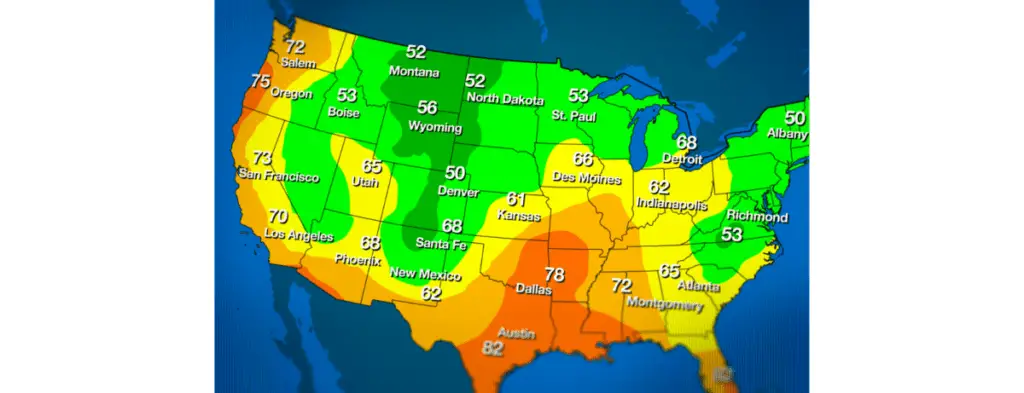
What is a Plant Hardiness Zone? We have divided the country into different zones into the United States based on the average lowest winter temperatures. These zones are important because they tell us which plants are likely to survive. Knowing your hardiness zone can help you choose plants more likely to thrive in your climate.
There are a total of 11 hardiness zones in the United States, and the number represents each one from 1 to 11. Zone 1 is the coldest, while Zone 11 is the warmest. Here is a breakdown of each zone:
Zone 1:
The average lowest temperature in Zone 1 is -60 degrees Fahrenheit. This zone is found in parts of Alaska, and very few plants can survive here.
Zone 2:
The average lowest temperature in Zone 2 is -50 degrees Fahrenheit. This zone is found in parts of Alaska, and very few plants can survive here.
Zone 3:
The average lowest temperature in Zone 3 is -40 degrees Fahrenheit. This zone is found in parts of Alaska, Montana, North Dakota, South Dakota, and Wyoming. Only the hardiest plants can survive here.
Zone 4:
The average lowest temperature in Zone 4 is -30 degrees Fahrenheit. This zone is found in parts of Colorado, Idaho, Iowa, Minnesota, Montana, Nebraska, North Dakota, South Dakota, Utah, and Wyoming. Only the hardiest plants can survive here.
Zone 5:
The average lowest temperature in Zone 5 is -20 degrees Fahrenheit. This zone is found in parts of Arkansas, Colorado, Illinois, Indiana, Iowa, Kansas, Louisiana, Michigan, Minnesota, Missouri, Nebraska, Oklahoma, South Dakota, and Wisconsin. A wide variety of plants can survive here.
Zone 6:
The average lowest temperature in Zone 6 is -10 degrees Fahrenheit. This zone is found in parts of Arizona, Colorado, Illinois, Indiana, Iowa, Kansas, Louisiana, Michigan, Minnesota, Missouri, Nebraska, Nevada, Oklahoma, and Wisconsin. A wide variety of plants can survive here.
Zone 7:
The average lowest temperature in Zone 7 is 0 degrees Fahrenheit. This zone is found in parts of California, Idaho, Nevada, Oregon, Utah, and Washington. A wide variety of plants can survive here.
Zone 8:
The average lowest temperature in Zone 8 is 10 degrees Fahrenheit. This zone is found in parts of California, Nevada, Oregon, and Washington. A wide variety of plants can survive here.
Zone 9:
The average lowest temperature in Zone 9 is 20 degrees Fahrenheit. This zone is found in parts of Arizona, California, Nevada, and Utah. A wide variety of plants can survive here.
Zone 10:
The average lowest temperature in Zone 10 is 30 degrees Fahrenheit. This zone is found in parts of Arizona, California, Hawaii, and Florida. A wide variety of plants can survive here.
Zone 11:
The average lowest temperature in Zone 11 is 40 degrees Fahrenheit. This zone is found in parts of Hawaii and Florida. A wide variety of plants can survive here.
How do you know which zone you are in?
If you’re unsure of what your hardiness zone is, you can find it on the USDA Plant Hardiness Zone Map. The map is color-coded, so finding your zone is easy. Simply locate your state on the map, and the corresponding number will tell you which zone you are in.
If you want to be even more specific, you can visit the Plant Hardiness Zone Calculator. This website will ask for your zip code and then give you your exact hardiness zone.
Here is a basic Hardiness Zone list of zones by state (paid link):
| States | Hardiness Zones |
| Alabama | Zones 7b to 8b |
| Alaska | Zones 2a-10a |
| Arizona | Zones 5a-10b |
| Arkansas | Zones 6a-9b |
| California | Zones 7a-11b |
| Colorado | Zones 3a-10b |
| Connecticut | Zones 5a-8d |
| Delaware | Zones 6a -7b |
| District of Columbia | Zones 8a – 10B |
| Florida | Zones 8A – 11B |
| Georgia | Zones 7A – 10B |
| Hawaii | Zones 11-11 |
| Idaho | Zones 4A – 10B |
| Illinois | Zones 5A – 10B |
| Indiana | Zones 5A – 9B |
| Iowa | Zones 4A – 9B |
| Kansas | Zones 5A – 9B |
| Kentucky | Zones 6A – 9B |
| Louisiana | Zones 7A – 10B |
| Maine | Zones 3A – 10B |
| Maryland | Zones 6A – 8B |
| Massachusetts | Zones 5A-8B |
| Michigan | Zones 4b-9a |
| Minnesota | Zones 4b-8b |
| Mississippi | Zones 7A-9B |
| Missouri | Zones 5b – 9a |
| Montana | Zones 3b – 10a |
| Nebraska | Zones 4b – 8b |
| Nevada | Zones 6a -11a |
| New Hampshire | Zones 3B – 8B |
| New Jersey | Zones 6A – 8B |
| New Mexico | Zones 6A – 10B |
| New York | Zones 5b – 9a |
| North Carolina | Zones 7b – 9a |
| North Dakota | Zones 3b – 10a |
| Ohio | Zones 5A-9B |
| Oklahoma | Zones 6A-10B |
| Oregon | Zones 8A-11B |
| Pennsylvania | Zones 5A-9A |
| Rhode Island | Zones 7B-10A |
| South Carolina | Zones 8A – 10B |
| South Dakota | Zones 4a – 9b |
| Tennessee | Zones 6b – 8a |
| Texas | Zones 7b – 10b |
| Utah | Zones 6a -11a |
| Vermont | Zones 3B-8B |
| Virginia | Zones 7a – 9b |
| Washington | Zones 6A-9B |
| West Virginia | Zones 6a – 8b |
| Wisconsin | Zones 4B-5A |
| Wyoming | Zones 4b – 10a |
Why do hardiness zones matter?
When you’re planting a garden, it’s important to choose plants that will be able to survive the climate in your area. If you live in an area with a cold climate, you’ll need to choose plants that are hardy enough to survive the cold winters. Similarly, if you live in an area with a hot climate, you’ll need to choose plants that can withstand the heat.
Hardiness zones are a helpful guide to choosing plants that will survive the climate in your area. However, they are not the only factor to consider. You’ll also need to consider the amount of sunlight and rainfall in your area, as well as the soil type. With all these factors in mind, you’ll be able to choose plants that will thrive in your garden.
What to Grow in Your Hardiness Zone?
Now that you know which hardiness zone you live in, you can start choosing plants for your garden. Here are some general guidelines to help you get started:
Zone 1:
If you live in Zone 1, you can grow a wide variety of plants. Some hardy options include roses, lilies (paid link), and irises. Learn all about roses in our Your Rose Questions Answered post!
Zone 2:
If you live in Zone 2, you can grow a wide variety of plants. Some hardy options include roses, lilies, and irises.
Zone 3:
In Zone 3, you can grow a wide variety of vegetables, including peas, carrots, potatoes, and cabbage. You can also grow herbs, such as parsley and rosemary. Learn how to grow carrots here or check out our guide to preserving herbs here.
Zone 4:
In Zone 4, you can grow most of the vegetables that do well in Zone 3. You can also add tomatoes (paid link), peppers, and eggplants to your garden. Check out our guide to growing tomatoes in this post.
Zone 5:
In Zone 5, you can grow all of the vegetables that do well in Zone 4. You can also add melons, squash, and beans to your garden.
Zone 6:
In Zone 6, you can grow all of the vegetables that do well in Zone 5. You can also add corn, cucumbers, and pumpkins to your garden. Learn how to fix common cucumber problems in this post.
Zone 7:
In Zone 7, you can grow all of the vegetables that do well in Zone 6. You can also add okra, peanuts, and sweet potatoes to your garden.
Zone 8:
In Zone 8, you can grow all of the vegetables that do well in Zone 7. You can also add lima beans, watermelons, and cantaloupes to your garden.
Zone 9:
In Zone 9, you can grow all of the vegetables that do well in Zone 8. You can also add peppers, eggplants, and tomatoes to your garden.
Zone 10:
In Zone 10, you can grow all of the vegetables that do well in Zone 9. You can also add squash, melons, and beans to your garden.
Zone 11:
In Zone 11, you can grow all of the vegetables that do well in Zone 10. You can also add corn, cucumbers, and pumpkins to your garden.
There are a few inconsistencies and exceptions to the hardiness zones. For example, the high elevations of the Rocky Mountains are generally cooler than other parts of the country, so their hardiness zones are lower than you would expect. Similarly, the Gulf Coast is generally warmer than other parts of the country, so their hardiness zones are higher than you would expect.
When in doubt, it’s always best to err on the side of caution. If you’re not sure whether a plant will be hardy enough for your area, it’s best to choose a different one. With so many options available, you’re sure to find a plant that will thrive in your garden.
This post contains affiliate links. If you make a purchase through these links, we may receive compensation at no additional cost to you.




